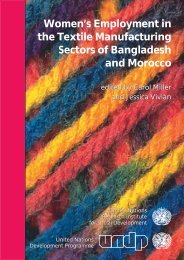The Politics of Gender and Reconstruction in Afghanistan
The Politics of Gender and Reconstruction in Afghanistan
The Politics of Gender and Reconstruction in Afghanistan
Create successful ePaper yourself
Turn your PDF publications into a flip-book with our unique Google optimized e-Paper software.
EVOLVING INSTITUTIONAL FRAMEWORKS AND WOMEN’S RIGHTS:<br />
POTENTIALS AND LIMITATIONS • CONCLUSION PAGE 31<br />
from 54 per cent (40 per cent for girls) to 100 per cent for boys <strong>and</strong> girls by 2015, the under-five mortality rate<br />
to decl<strong>in</strong>e from 172 to 130 per 1,000 live births, the <strong>in</strong>fant mortality rate from 115 to 55 per 1,000 live births,<br />
<strong>and</strong> the maternal mortality rate from an estimated 1,600 per 100,000 live births to 205. <strong>The</strong>se are goals that<br />
require long-term commitment <strong>and</strong> susta<strong>in</strong>ed <strong>in</strong>vestment. <strong>The</strong>re is a problematic disjuncture between, on the<br />
one h<strong>and</strong>, the time frames adopted <strong>and</strong> outputs expected by the <strong>in</strong>ternational actors driv<strong>in</strong>g the women’s<br />
rights agenda, <strong>and</strong> on the other, the length <strong>of</strong> time required for non-cosmetic changes <strong>in</strong> societal relations to<br />
beg<strong>in</strong> to take shape. This disjuncture may itself produce un<strong>in</strong>tended consequences that may prove detrimental<br />
to women unless great care is taken to pay heed to local needs <strong>and</strong> priorities.<br />
V.<br />
conclusion<br />
It has been argued throughout this text that issues <strong>of</strong><br />
gender equity <strong>and</strong> women’s rights <strong>in</strong> <strong>Afghanistan</strong> can only<br />
be mean<strong>in</strong>gfully addressed <strong>in</strong> the context <strong>of</strong> the multiple<br />
transitions entailed by the process <strong>of</strong> post-conflict reconstruction:<br />
a transition from conflict <strong>and</strong> <strong>in</strong>security to peace, a political transition to a legitimate <strong>and</strong> effective<br />
state, <strong>and</strong> a socioeconomic transition to susta<strong>in</strong>able economic growth. <strong>The</strong>se transformations do not take<br />
place <strong>in</strong> a social vacuum but necessarily build upon exist<strong>in</strong>g political, market <strong>and</strong> domestic <strong>in</strong>stitutions that<br />
def<strong>in</strong>e both the constra<strong>in</strong>ts <strong>and</strong> opportunities for future developments.<br />
<strong>The</strong>re is, at present, a potentially disabl<strong>in</strong>g lag between the different facets <strong>of</strong> these transformations. Susta<strong>in</strong>ed<br />
efforts have been made by the <strong>in</strong>ternational community, the government <strong>of</strong> <strong>Afghanistan</strong> <strong>and</strong> local women’s<br />
NGOs to ensure that legal <strong>and</strong> governance reforms address gender equity issues <strong>and</strong> support the civic <strong>and</strong><br />
political participation <strong>of</strong> women. A national mach<strong>in</strong>ery has been created to promote <strong>and</strong> monitor gender<br />
ma<strong>in</strong>stream<strong>in</strong>g <strong>in</strong> national development efforts, <strong>and</strong> the constitutional development process has addressed the<br />
issue <strong>of</strong> women’s political participation. However, the security <strong>and</strong> socioeconomic conditions have not kept pace<br />
with political <strong>and</strong> juridical reforms, result<strong>in</strong>g <strong>in</strong> a grow<strong>in</strong>g gap between women’s formal rights <strong>and</strong> their actual<br />
ability to avail themselves <strong>of</strong> those rights.<br />
Significant obstacles need to be overcome for the promises <strong>of</strong> reconstruction <strong>and</strong> national consolidation to<br />
materialize for women. As the historical record <strong>in</strong>dicates, women’s rights have always been a contested issue <strong>in</strong><br />
<strong>Afghanistan</strong>, with periods <strong>of</strong> reform followed by violent backlash <strong>and</strong> curtailment <strong>of</strong> rights. <strong>The</strong>re are cont<strong>in</strong>u<strong>in</strong>g<br />
tensions between the stipulations <strong>of</strong> <strong>in</strong>ternational human rights <strong>in</strong>struments (<strong>in</strong>clud<strong>in</strong>g CEDAW, to which the<br />
government <strong>of</strong> <strong>Afghanistan</strong> is a signatory), Islamic jurisprudence <strong>and</strong> Afghan customary law. <strong>The</strong>se tensions can<br />
neither be addressed nor resolved without a political settlement that ensures stability <strong>and</strong> the rule <strong>of</strong> law. In<br />
the absence <strong>of</strong> a process <strong>of</strong> national consolidation <strong>and</strong> reconciliation, there is a grow<strong>in</strong>g risk that women’s<br />
rights issues will rema<strong>in</strong> hostage to factional struggles, <strong>and</strong> that Islam will be deployed as a political tool rather<br />
than a universal faith that enjo<strong>in</strong>s believers to uphold ideals <strong>of</strong> social justice <strong>and</strong> equality.
















